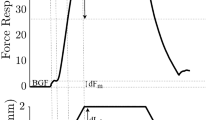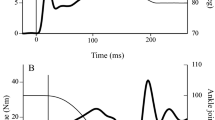Summary
The recovery behaviour of mechanically evoked stretch responses was investigated. Stimuli which promoted identical dorsiflexing movements around the ankle joint were applied to ten subjects in two positions, seated and upright. The experimental sets comprised single as well as double dorsiflexing displacements. In the latter the stimuli were elicited for durations of either 100, 200 or 400 ms. Stretch responses following the first displacements were related to the stretch velocity but not to the amplitude. The responses of the plantar flexors following the second mechanical dorsiflexion were reduced with respect to the delay time between the first and second displacement. In addition, the magnitudes of these responses depended on the functional task: the stretch responses recovered much faster in the standing position when the triceps surae muscle was only slightly activated, whereas in the relaxed sitting position the reflexes remained suppressed. Both reciprocal inhibition, as well as the time course of the reformation of intrafusal cross-bridge links, may help to explain the depression of the monosynaptic stretch reflex.
Similar content being viewed by others
References
Berardelli A, Hallett M, Kaufmann C, Fine E, Berenberg W, Simon SR (1982) Stretch reflexes of triceps surae in normal man. J Neurol Neurosurg Psychiatry 45:513–525
Capek R, Esplin B (1977) Homosynaptic depression and transmitter turnover in spinal monosynaptic pathway. J Neurophysiol 40:95–104
Dietz V (1992) Human neuronal control of automatic functional movements: interaction between central programs and afferent input. Physiol Rev 72:33–69
Dietz V, Discher M, Faist M, Trippel M (1990a) Amplitude modulation of the human quadriceps tendon jerk reflex during gait. Exp Brain Res 82:211–213
Dietz V, Gollhofer A, Horstmann GA, Trippel M (1990b) Postural adjustments and gravity. J Physiol 420:21
Gollhofer A (1987) Komponenten der Schnellkraftleistungen im Dehnungs-Verkürzungs-Zyklus. SFT, Erlensee
Gollhofer A, Schmidtbleicher D (1989) Stretch reflex responses of the human m. triceps surae following mechanical stimulation. In: Gregor RJ, Zernicke RF, Whiting WC (eds) Proceedings of the XII International Congress of Biomechanics in Los Angeles. University of California, Los Angeles, pp 219–220
Gollhofer A, Horstmann GA, Berger W, Dietz V (1989) Compensation of translational and rotational perturbations in human posture: stabilization of the centre of gravity. Neurosci Lett 105:73–78
Gottlieb GL, Agarwal GC (1979) Response to sudden torques about ankle in man: myotatic reflex. J Neurophysiol 42:91–106
Gottlieb GL, Agarwal GC (1980) Response to sudden torques about ankle in man: II. Postmyotatic reactions. J Neurophysiol 43:86–101
Gottlieb GL, Agarwal GC, Jaeger RJ (1981) Response to sudden torques about ankle in man. IV. A functional role of α-γ linkage. J Neurophysiol 46:179–190
Gregory JE, Prochazka A, Proske U (1977) Responses of muscle spindles to stretch after period of fusimotor activity compared in freely moving and anaesthetized cats. Neurosci Lett 4:67–72
Höhler FK, McCann MA, Bernick DL (1981) Habituation of the Hoffman reflex. Brain Res 220:299–307
Horstmann GA, Dietz V (1990) A basic posture control mechanism: the stabilization of the centre of gravity. Electroencephal Clin Neurophysiol 76:165–176
Hutton RS, Enoka RM, Suzuki S (1983) Activation history of muscle and changes in human reflex excitability. In: Matsui H, Kobayashi K (eds) Biomechanics VIII-A. International Series on Biomechanics. Human Kinetics, Champaign, Ill., pp 302–305
Katz R, Morin C, Pierrot-Deseilligny E, Hibino R (1977) Conditioning of H-reflex by a preceding sub-threshold tendon reflex stimulus. J Neurol Neurosurg Psychiatry 40:575–580
Lee RG, Tatton WG (1978) Longloop reflexes in man: clinical applications. In: Desmedt JE (ed) Cerebral motot control in man: long loop mechanisms. Karger, Basle, pp 246–262
Marsden CD, Merton PA, Morton HB (1976) Stretch reflex and servo action in a variety of human muscles. J Physiol 259:531–560
Nelson DL, Hutton RS (1985) Dynamic and static stretch responses in muscle spindle receptors in fatigued muscle. Med Sci Sports Exerc 17:445–450
Rack PMH (1981) Limitations of somatosensory feedback in control of posture and movement. In: Brooks VB (ed) Handbook of physiology. The nervous system II, 1. Waverly Press, Baltimore, pp 229–256
Rothwell JC, Day BL, Berardelli A, Marsden CD (1986) Habituation and conditioning of the human long latency stretch reflex. Exp Brain Res 63:197–204
Panizza M, Lelli S, Nilsson J, Hallett M (1990) H-reflex recovery curve and reciprocal inhibition of H-reflex in different kinds of dystonia. Neurology 40:824–828
Wolpaw JR (1987) Operant conditioning of primate spinal reflexes: the H-reflex. J Neurophysiol 57:443–459
Author information
Authors and Affiliations
Rights and permissions
About this article
Cite this article
Gollhofer, A., Rapp, W. Recovery of stretch reflex responses following mechanical stimulation. Europ. J. Appl. Physiol. 66, 415–420 (1993). https://doi.org/10.1007/BF00599614
Accepted:
Issue Date:
DOI: https://doi.org/10.1007/BF00599614




